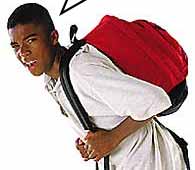

Backpack Misuse Leads to Chronic Back Pain
This section is compiled by Frank M. Painter, D.C.
Send all comments or additions to: Frankp@chiro.org




Thanks to the ACA for permission to reproduce this article!
Back pain is pervasive among American adults, but a new and disturbing trend is emerging. Young children are suffering from back pain much earlier than previous generations, and the use of overweight backpacks is a contributing factor, according to the American Chiropractic Association (ACA). In fact, the U.S. Consumer Product Safety Commission reports that backpack-related injuries sent more than 7,000 people to the emergency room in 2001 alone.
"In my own practice, I have noticed a marked increase in the number of young children who are complaining about back, neck and shoulder pain," said Dr. Scott Bautch, immediate past president of the ACA's Council on Occupational Health. "The first question I ask these patients is, 'Do you carry a backpack to school?' Almost always, the answer is 'yes.'"
This new back pain trend among youngsters isn't surprising when you consider the disproportionate amounts of weight they carry in their backpacks - often slung over just one shoulder. According to Dr. Bautch, a recent study conducted in Italy found that the average child carries a backpack that would be the equivalent of a 39-pound burden for a 176-pound man, or a 29-pound load for a 132-pound woman. Of those children carrying heavy backpacks to school, 60 percent had experienced back pain as a result.
According to Dr. Bautch, preliminary results of studies being conducted in France show that the longer a child wears a backpack, the longer it takes for a curvature or deformity of the spine to correct itself. "The question that needs to be addressed next is, 'Does it ever return to normal?'" Dr. Bautch added.
The results of these types of studies are especially important as more and more school districts - many of them in urban areas - remove lockers from the premises, forcing students to carry their books with them all day long.
The problem has become so widespread, in fact, that the California State Assembly recently passed legislation that would force school districts to develop ways of reducing the weight of students' backpacks. Similar legislation is being considered in New Jersey as well. The ACA believes that limiting the backpack's weight to no more than 10 percent of the child's body weight and urging the use of ergonomically correct backpacks are possible solutions.
What Can You Do?
The ACA offers the following tips to help prevent the needless pain that backpack misuse could cause the students in your household.
Make sure your child's backpack weighs no more than 5 to 10 percent of his or her body weight. A heavier backpack will cause your child to bend forward in an attempt to support the weight on his or her back, rather than on the shoulders, by the straps.
The backpack should never hang more than four inches below the waistline. A backpack that hangs too low increases the weight on the shoulders, causing your child to lean forward when walking.
A backpack with individualized compartments helps in positioning the contents most effectively. Make sure that pointy or bulky objects are packed away from the area that will rest on your child's back.
Bigger is not necessarily better. The more room there is in a backpack, the more your child will carry-and the heavier the backpack will be.
Urge your child to wear both shoulder straps. Lugging the backpack around by one strap can cause the disproportionate shift of weight to one side, leading to neck and muscle spasms, as well as low-back pain.
Wide, padded straps are very important. Non-padded straps are uncomfortable, and can dig into your child's shoulders.
The shoulder straps should be adjustable so the backpack can be fitted to your child's body. Straps that are too loose can cause the backpack to dangle uncomfortably and cause spinal misalignment and pain.
If the backpack is still too heavy, talk to your child's teacher. Ask if your child could leave the heaviest books at school, and bring home only lighter hand-out materials or workbooks.
Although the use of rollerpacks - or backpacks on wheels - has become popular in recent years, the ACA is now recommending that they be used cautiously and on a limited basis by only those students who are not physically able to carry a backpack. Some school districts have begun banning the use of rollerpacks because they clutter hallways, resulting in dangerous trips and falls.
Consider the ACA-endorsed Samsonite Chiropak, a school bag designed to ease much of the stress that carrying books can place on one's body. Among other features, the Chiropak offers comfortable body-contact surfaces and an adjustable hip/waist belt. For more information on the Chiropak, visit www.chiropak.com or www.samsonite.com.
Chiropractic Care Can Help
If you or your child experiences any pain or discomfort resulting from backpack use, call your doctor of chiropractic. Doctors of chiropractic are licensed and trained to diagnose and treat patients of all ages and will use a gentler type of treatment for children. In addition, doctors of chiropractic can also prescribe exercises designed to help children develop strong muscles, along with instruction in good nutrition, posture and sleeping habits.
Chiropractic in Cyberspace
If you like to surf the Net, check out the American Chiropractic Association's Web site. Not only can you find a doctor of chiropractic near you, but you can also obtain additional information about preventing spinal pain and injury, read important studies about the effectiveness of chiropractic care, and learn about chiropractic education and the history of the chiropractic profession. Visit us today at www.acatoday.com or call us at 800/986/4636.

Return to BACKPACKS


| Home Page | Visit Our Sponsors | Become a Sponsor |
Please read our DISCLAIMER |
